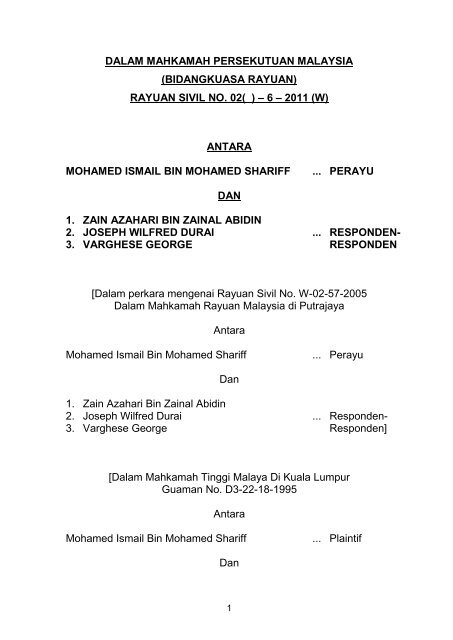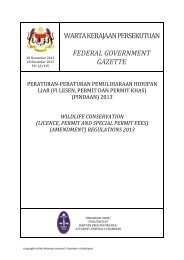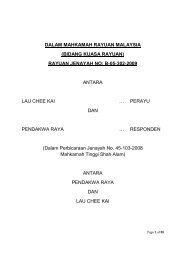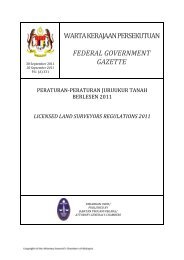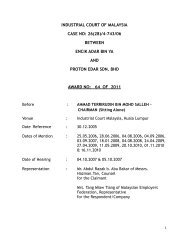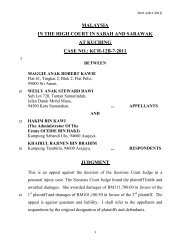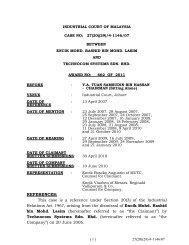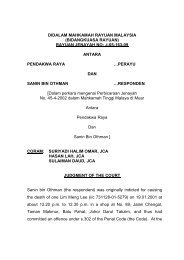rayuan sivil no. 02( ) – 6 – 2011 (w) - Malaysian Legal and Tax ...
rayuan sivil no. 02( ) – 6 – 2011 (w) - Malaysian Legal and Tax ...
rayuan sivil no. 02( ) – 6 – 2011 (w) - Malaysian Legal and Tax ...
Create successful ePaper yourself
Turn your PDF publications into a flip-book with our unique Google optimized e-Paper software.
DALAM MAHKAMAH PERSEKUTUAN MALAYSIA<br />
(BIDANGKUASA RAYUAN)<br />
RAYUAN SIVIL NO. <strong>02</strong>( ) <strong>–</strong> 6 <strong>–</strong> <strong>2011</strong> (W)<br />
ANTARA<br />
MOHAMED ISMAIL BIN MOHAMED SHARIFF ... PERAYU<br />
DAN<br />
1. ZAIN AZAHARI BIN ZAINAL ABIDIN<br />
2. JOSEPH WILFRED DURAI ... RESPONDEN-<br />
3. VARGHESE GEORGE RESPONDEN<br />
[Dalam perkara mengenai Rayuan Sivil No. W-<strong>02</strong>-57-2005<br />
Dalam Mahkamah Rayuan Malaysia di Putrajaya<br />
Antara<br />
Mohamed Ismail Bin Mohamed Shariff ... Perayu<br />
Dan<br />
1. Zain Azahari Bin Zainal Abidin<br />
2. Joseph Wilfred Durai ... Responden-<br />
3. Varghese George Responden]<br />
[Dalam Mahkamah Tinggi Malaya Di Kuala Lumpur<br />
Guaman No. D3-22-18-1995<br />
Antara<br />
Mohamed Ismail Bin Mohamed Shariff ... Plaintif<br />
Dan<br />
1
1. Zain Azahari Bin Zainal Abidin<br />
2. Joseph Wilfred Durai ... Defendan-<br />
3. Varghese George Defendan]<br />
Coram: Arifin B. Zakaria, CJ<br />
Hashim B. Dato’ Hj. Yusoff, FCJ<br />
Abdull Hamid B. Embong, FCJ<br />
JUDGMENT OF THE COURT<br />
1. This Court had granted leave to the Appellant on two questions<br />
of law viz:-<br />
‘i. Whether on its true <strong>and</strong> proper construction of the Report<br />
of Azman, Wong, Salleh & Co. (AWS Report) dated 18 th<br />
November 1985 <strong>and</strong> titled “ZAIN & CO. VALUATION OF<br />
GOODWILL” constitutes a report on the valuation of<br />
goodwil of the firm only or also the valuation of all the<br />
other assets of the firm including goodwill?<br />
ii. Is the court when faced with conflicting expert reports,<br />
including such reports as specifically directed by it to be<br />
produced <strong>and</strong> tendered in Court, required in law to<br />
consider <strong>and</strong> rule upon the views as expressed in all the<br />
reports <strong>and</strong> h<strong>and</strong> down its reasoned decision on the<br />
issues as opined upon in all the said reports so as to<br />
accord transparency to the said decision?’<br />
2
Background Facts<br />
2. Messrs Zain & Co. (“the Firm”) is a firm of solicitors in Kuala<br />
Lumpur. The Appellant was a partner of the Firm from<br />
1/11/1970 to 31/12/1988, when he retired as a partner of the<br />
Firm.<br />
3. The 1 st Respondent <strong>and</strong> the Appellant together with one Lai<br />
Kee Chung (“Lai”) were the founding partners of the Firm with<br />
the 1 st Respondent holding a 70% equity, whilst the Appellant<br />
<strong>and</strong> Lai each held 15% equity in the Firm. It was agreed that<br />
the retirement or death of any partner shall <strong>no</strong>t have the effect<br />
of dissolving the partnership <strong>and</strong> <strong>no</strong>ne of the partners shall<br />
have the right at any time for any cause whatsoever to<br />
determine the partnership. Lai retired from the Firm on<br />
30/11/1976.<br />
4. The 2 nd <strong>and</strong> 3 rd Respondents were admitted as partners of the<br />
Firm on 01/01/1980. They were informed, when invited to<br />
become partners in late 1979 by the 1 st Respondent, that their<br />
respective shares in the Firm would be 12% <strong>and</strong> 11% <strong>and</strong> that<br />
their respective shares would be valued. They would <strong>no</strong>t have<br />
to pay immediately for their respective shares but the values<br />
would be debited to their respective capital accounts.<br />
5. The auditors valued the Firm as at 01/01/1980 at<br />
RM1,500,000.00 <strong>and</strong> the report is dated 18/11/1985. The<br />
auditors used “the surplus profit” method of valuation of the<br />
Firm, an accepted method of valuation of a professional<br />
3
practice. The valuation of the Firm at RM1,500,000.00 was<br />
accepted by both the Appellant <strong>and</strong> the Respondents.<br />
6. Immediately prior to the admission of the 2 nd <strong>and</strong> 3 rd<br />
Respondents as partners, the Appellant held 40% equity <strong>and</strong><br />
the 1 st Respondent held 60% equity of the Firm. Therefore the<br />
value of their respective shares as at 01/01/1980 was<br />
RM600,000.00 <strong>and</strong> RM900,000.00.<br />
7. Upon admission of the 2 nd <strong>and</strong> 3 rd Respondents as partners of<br />
the Firm on 01/01/1980, the Appellant <strong>and</strong> the 1 st Respondent<br />
divested 6.5% <strong>and</strong> 16.5% of their shares respectively. Thus,<br />
23% equity of the Firm was divested to the new partners, i.e.<br />
12% to the 2 nd Respondent <strong>and</strong> 11% to the 3 rd Respondent.<br />
From this exercise, the Appellant was entitled to a sum of<br />
RM97,500.00, being the value of 6.5% of his shares which he<br />
divested to the 2 nd <strong>and</strong> 3 rd Respondents, <strong>and</strong> correspondingly<br />
the 1 st Respondent was entitled for a sum of RM247,500.00<br />
being the value of 16.5% of his shares which he divested to the<br />
2 nd <strong>and</strong> 3 rd Respondents.<br />
8. In 1985, the Firm appointed new auditors viz, Arthur Anderson<br />
& Co. who were instructed to undertake a review of the Firm’s<br />
partnership structure. They produced a report dated<br />
03/10/1986 (“the AA Review <strong>and</strong> Evaluation Report of 1986”),<br />
wherein “Goodwill” was defined.<br />
9. On 22/11/1986, the partners of the Firm at the material time<br />
(including one Mr. Lloyd Fern<strong>and</strong>o) met <strong>and</strong> discussed the<br />
4
eport. The partners accepted the report subject to the<br />
reservation that, in the event of the value of the share of any<br />
retiring partner on the time of retirement was lower than its<br />
value, at the time of acquisition, the deficit need <strong>no</strong>t be paid by<br />
the retiring partner, provided his retirement was after 2 years of<br />
his admission to the partnership.<br />
10. On his retirement, on 31/12/1988 as a founding partner, the<br />
Appellant requested for his share in the Firm as at the date of<br />
his retirement to be valued. The Firm forwarded to him a copy<br />
of the audited accounts of the Firm as at 31/12/1988. It showed<br />
that the Appellant owed the Firm the sum of RM327,096.00.<br />
However the Firm, in a covering letter dated 04/10/1989<br />
forwarding the said account, informed the Appellant that the<br />
outst<strong>and</strong>ing amount presently due from him was<br />
RM320,096.00 after taking into account the sum of<br />
RM7,000.00 deducted from fees paid by Tobisma Corporation.<br />
The Appellant was asked how he proposed to settle the<br />
amount of RM320,096.00 which was then owing by the<br />
Appellant to the Firm, <strong>and</strong> according to the auditors’ report was<br />
supposed to be settled within one year from his retirement. The<br />
Appellant in his reply, did <strong>no</strong>t dispute the amount he owed was<br />
RM320,096.00 <strong>and</strong> that it was payable within one year of his<br />
retirement, but stated that he believed the value of his share in<br />
the Firm at the time of his retirement would be in excess of the<br />
amount due in his current account.<br />
11. By a document dated 20/09/1990, the Arthur Anderson auditors<br />
made a determination of what was due to the Appellant on his<br />
5
etirement on 31/12/1988. However it was the auditors’<br />
determination that the net amount of RM215,521.00 was due<br />
from the Appellant to the Respondents instead.<br />
Proceedings in the High Court<br />
12. The Appellant was aggrieved about the valuation of his<br />
entitlement on his retirement from the Firm. He therefore filed<br />
an action in the High Court against the Respondents making<br />
various claims as constituting the value of his share in the Firm.<br />
The Respondents filed a counter claim of RM62,000.00 against<br />
the Appellant from the value of the car registration No. BBT 55.<br />
13. On 10/12/2004, the High Court dismissed the whole of the<br />
Appellant’s claim except the claim for 5% absolute shares of<br />
the Firm’s net profit but limited the same only from 01/01/1989<br />
to 31/12/1989. The learned High Court Judge allowed the<br />
Respondents’ counter claim.<br />
Proceedings in the Court of Appeal<br />
14. Thereafter, the Appellant filed an appeal to the Court of Appeal<br />
against:-<br />
(i) The whole decision of the High Court in dismissing the<br />
Appellant’s prayers for declarations, orders <strong>and</strong> claims,<br />
save as to the 5% absolute share in the Firm’s net profit.<br />
(ii) That part of the decision of the High Court in deciding<br />
that the Appellant is only entitled to the 5% absolute<br />
6
shares of the Firm’s net profits for the period of one year<br />
only i.e. from 01/01/1989 to 31/12/1989 <strong>and</strong> <strong>no</strong>t also to<br />
those of the subsequent years, <strong>and</strong><br />
(iii) The decision of the High Court in granting the<br />
Respondents’ counter claim of RM62,000.00 with costs.<br />
15. The Respondents also filed a cross appeal against the decision<br />
of the High Court in deciding that the Appellant was entitled to<br />
the 5% absolute share of the Firm’s net profits.<br />
16. On 06/11/2009 the Court of Appeal dismissed the Appellant’s<br />
appeal with costs <strong>and</strong> allowed the Respondents’ cross appeal<br />
with <strong>no</strong> order as to costs.<br />
The Issues In This Appeal<br />
17. The Appellant’s appeal before us involves the determination on<br />
the true <strong>and</strong> proper construction of the Azman, Wong, Salleh &<br />
Co. (AWS) Report, i.e. whether it was a valuation of only the<br />
Goodwill or a valuation of the entire Firm of Zain & Co. In other<br />
words, the issue is whether the value of a retiring partner’s<br />
share in the Firm as at the date of his retirement is the<br />
valuation of both the Goodwill of the Firm as well as the assets<br />
of the Firm or only the Goodwill?<br />
18. It also involves the issue as to the duty of the trial Court when<br />
faced with the conflicting valuation reports to consider <strong>and</strong> rule<br />
upon the views as expressed in all the reports <strong>and</strong> h<strong>and</strong> down<br />
7
its reasoned decision on the issue as opined upon it in all the<br />
reports so as to accord transparency to the said decision.<br />
19. Further this instant appeal concerns the effect of the Court of<br />
Appeal’s decision in endorsing the trial judge’s decision given<br />
without a reasoned decision <strong>and</strong> without the Court of Appeal<br />
itself considering the reports <strong>and</strong> giving its independent ruling<br />
on the basis thereof so as to avoid any injustice to the<br />
Appellant.<br />
The Case for the Appellant<br />
20. Learned counsel for the Appellant submitted that the<br />
Respondents’ contention that the Appellant’s entitlement on his<br />
retirement from the Firm on 31/12/1988 was limited only to the<br />
value of the Goodwill of the Firm <strong>and</strong> <strong>no</strong>t the value of the<br />
Goodwill <strong>and</strong> the assets of the Firm on the basis of the Azman,<br />
Wong, Salleh & Co. (AWS) Report is incorrect.<br />
21. He submitted that there were 4 valuation reports done viz:-<br />
(i) The “Zain & Co. Valuation of Goodwill” as at 1 st January<br />
1980 by Azman, Wong, Salleh & Co. (AWS Report 1985);<br />
(ii) The Review <strong>and</strong> Evaluation of the Partnership of Zain &<br />
Co. by Arthur Anderson & Co. (AA Report 1986);<br />
(iii) The Goodwill computation dated 20 September, 1990 by<br />
Arthur Anderson & Co. (AA Report 1990).<br />
8
(iv) The report by Lee Yat Kong from Wong, Lee & Co. (LYK<br />
Report 1995) as directed by the trial Judge.<br />
22. It was further submitted that the AA Report 1990 was only a<br />
valuation of the Goodwill of the Firm <strong>and</strong> did <strong>no</strong>t include its<br />
assets. Therein, the amount of Goodwill by the Appellant was<br />
stated as RM5<strong>02</strong>,000.00. Likewise in the AA Report 1986, the<br />
valuation was also for Goodwill only <strong>and</strong> did <strong>no</strong>t include the<br />
assets of the Firm.<br />
23. In the AA Report 1986, “Goodwill” was defined “as that element<br />
of premium that can be attached to a business due to certain<br />
attributes of the business which may include, inter alia, the<br />
following:-<br />
(i) the reputation <strong>and</strong> the business contacts of the founding<br />
partners;<br />
(ii) the existing reputation <strong>and</strong> image of the Firm <strong>and</strong> its<br />
range of services;<br />
(iii) the location of the business;<br />
(iv) the existing clientele of the business.<br />
24. Counsel submitted that both Goodwill <strong>and</strong> the other assets of<br />
the Firm go to make up the value of the share; Goodwill alone<br />
does <strong>no</strong>t represent the value of the Appellant’s share. The<br />
assets have also to be valued before the value of the<br />
Appellant’s share could be determined.<br />
9
25. It was also contended by learned counsel for the Appellant that<br />
the learned trial Judge did <strong>no</strong>t consider all the reports<br />
presented before the Court, in particular the LYK Report 1995,<br />
prepared by the Appellant’s witness, SP2.<br />
The Case for the Respondents<br />
26. Learned counsel for the Respondents however submitted that<br />
the learned trial Judge had rightly rejected the Appellant’s claim<br />
that the assets of the Firm belonged to the Appellant <strong>and</strong> the<br />
1 st Respondent exclusively. It was contended that the position<br />
of a partner on his retirement was covered by the AA Report.<br />
The Appellant himself had accepted the recommendations of<br />
the AA Report without any qualification. Therefore the<br />
Appellant is <strong>no</strong>w estopped from denying that he was bound by<br />
what he himself had agreed to.<br />
27. It was further submitted by learned counsel that the Appellant<br />
was <strong>no</strong>t entitled to such share of the profits made since the<br />
dissolution of the partnership on 31 December, 1988 as may<br />
be attributable to his share of the partnership assets. Upon<br />
retirement from a partnership, a partner’s entire share in the<br />
Firm must be dealt with irrespective of whether it is an<br />
“absolute share” or <strong>no</strong>t in the absence of any unequivocal<br />
agreement to the contrary which is <strong>no</strong>t illegal or against public<br />
policy.<br />
28. The Respondents’ counsel also submitted that the term<br />
‘Goodwill’ calculated according to the “surplus-profits” method<br />
10
eferred to the value of the entire Firm. He referred to the<br />
evidence of SD4, a chartered accountant from the Firm of<br />
Azman, Wong, Salleh & Co. in relation to the ASW Report<br />
wherein SD4 said:-<br />
‘Goodwill in the context of a legal Firm is valuation of the<br />
practice at that point of time. The valuation is based on<br />
surplus profit method which is considered as the best<br />
method in valuing a business like legal practice. In<br />
arriving at the profit the assets of the practice has already<br />
been effected or taken into account of the profit of the<br />
practice. In the report I use the term Goodwill to de<strong>no</strong>te<br />
the value of the practice.”<br />
29. Under cross-examination SD4 stated that he did <strong>no</strong>t agree that<br />
in calculating the valuation of the purchase through the surplus<br />
profit method that he did <strong>no</strong>t take into account the assets of the<br />
practice (see AR Volume 3 at page 370). When asked what<br />
were the assets of the Firm, SD4 said, “The tangible assets<br />
would have been fixed assets like tables, chairs, vehicles,<br />
letters, work in progress, amount due by purchasers to the<br />
Firm, bills rendered but <strong>no</strong>t paid.”<br />
30. Learned counsel for the Respondents also referred to the<br />
evidence of SD5 who prepared the AA Report 1986. SD5 had<br />
said in his evidence (see AR Volume 3, page 371-372) that:-<br />
“The concept of goodwill is the same concept of the firm<br />
based on surplus profit concept. ... If this surplus profit<br />
11
This Court’s Decision<br />
method is used its value include the assets, liabilities <strong>and</strong><br />
profits in arriving at the value of the firm.<br />
In accounting pertaining the acceptable meaning of<br />
goodwill <strong>–</strong> carries two meanings, one the entire valuation<br />
of the practice <strong>and</strong> two is goodwill as a specific assets in<br />
the balance sheet of the entity. In this case the<br />
underst<strong>and</strong>ing is that if this method is used it refers to<br />
entire valuation of the practice.”<br />
31. It appears that there are conflicting valuation Reports regarding<br />
the value of the Appellant’s share upon his retirement on<br />
31/12/1988.<br />
32. From the four reports produced before the High court, three of<br />
them, i.e. the AWS Report 1985, the AA Report 1986 <strong>and</strong> the<br />
AA Report 1990 are based on the surplus-profit method of<br />
valuation <strong>and</strong> are in favour of the Respondents. The fourth<br />
Report (LYK Report 1995) however is in conflict with the other<br />
three reports.<br />
33. In the LYK Report 1995, Lee Yat Kong from the Public<br />
Accountancy Co. of Wong, Lee & Co., in giving evidence for<br />
the Appellant, had commented on the other three reports.<br />
Briefly, the LYK Report 1995, found that:-<br />
12
(a) The AWS Report 1985, has <strong>no</strong>t taken into account other<br />
assets besides Goodwill of the Firm for the following<br />
reasons:-<br />
(i) AWS Report clearly shows that it was a valuation of<br />
only the Goodwill of Zain & Co. <strong>and</strong> <strong>no</strong>t a valuation<br />
of the Firm itself including Goodwill <strong>and</strong> all other<br />
assets of the Firm.<br />
(ii) The assets of the Firm at the material time on<br />
01/01/1980 comprised of:-<br />
a) Goodwill;<br />
b) Capital;<br />
c) Fixed Assets<br />
i) Library books;<br />
ii) Furniture <strong>and</strong> fittings;<br />
iii) Office equipment;<br />
iv) Re<strong>no</strong>vation <strong>and</strong> partition;<br />
v) Motor vehicles;<br />
d) Bills rendered but unpaid;<br />
e) Work done but <strong>no</strong>t billed;<br />
f) Work in progress;<br />
g) Disbursements advanced to clients;<br />
h) Other monies owing to clients;<br />
i) Any other assets.<br />
(b) The AA Report 1990 is incomplete <strong>and</strong> incorrect because<br />
it is a computation of only the Goodwill of the Appellant<br />
13
<strong>and</strong> is <strong>no</strong>t a valuation of the Appellant’s share in the Firm<br />
at the date of his retirement on 31/12/1988.<br />
(c) Likewise the AA Report 1986, did <strong>no</strong>t value the Firm, as<br />
their basis of valuation was the same as the AWS Report<br />
1985, which only valued Goodwill of the Firm.<br />
(d) Similarly, the AA Report 1990, did <strong>no</strong>t value the Firm but<br />
only its Goodwill as their basis of valuation was the same<br />
as the AWS Report 1985.<br />
34. The LYK Report 1995 suggested that in the circumstances a<br />
proper valuation of the assets of the Firm should be carried out<br />
separately to determine the value of the Appellant’s share.<br />
35. It had referred to the book “The Valuation of Company Shares<br />
<strong>and</strong> Business” by A.V. Adamson <strong>and</strong> M.G. Correy (4 th Edition),<br />
particularly to Chapter 6 therein, regarding “CONSIDERATION<br />
OF METHODS OF VALUATION”. Under the said chapter, at<br />
page 52, under “Classification of Methods” it states, “In all of<br />
these instances, the total value of the business is arrived at by<br />
adding to the calculation of goodwill the estimated value of<br />
tangible assets.”<br />
36. Unfortunately we do <strong>no</strong>t have the full Grounds of Judgment of<br />
the trial Judge who had since passed away. But the Court of<br />
Appeal held that there was <strong>no</strong> dispute that after a full trial, the<br />
learned trial Judge made the following findings on 10<br />
December 2004:-<br />
14
‘Goodwill computation of firm by AA through report dated<br />
20/9/1990 (2 nd report by AA) AB2 550 was based on<br />
surplus-profit method took into consideration of all the<br />
assets of the firm. Goodwill valuation computation is<br />
such that the value of the whole firm was taken into<br />
account. This is clear from SD5’s evidence. The<br />
contention of the Plaintiff that the report did <strong>no</strong>t take into<br />
consideration assets of the firm is devoid of any merit <strong>and</strong><br />
as such rejected. For this reason I rule that the Plaintiff is<br />
<strong>no</strong>t entitled to a declaration that assets of the firm<br />
belongs to the Plaintiff <strong>and</strong> 1 st Defendant only <strong>and</strong> as<br />
such the 2 nd <strong>and</strong> 3 rd Defendants are liable for the use of<br />
assets of the firm. This contention is rejected <strong>and</strong> the<br />
claim is dismissed in respect of this contention.<br />
The Plaintiff’s claim for payment of other assets is also<br />
dismissed. The Plaintiff also claimed that the sum of<br />
RM69,309.00 for initial goodwill which was debited in the<br />
Plaintiff’s account was wrongly done. This is against the<br />
evidence by the accountant. I therefore find that on<br />
evidence this was <strong>no</strong>t wrongly debited <strong>and</strong> as such<br />
question of reversing the debit does <strong>no</strong>t arise. This claim<br />
is also dismissed.<br />
As regards Plaintiff’s claim for payment of absolute share<br />
of 5% I am of the view this claim should be allowed.<br />
However the Plaintiff is <strong>no</strong>t entitled for the payment<br />
forever as he has retired from the firm. I am of the opinion<br />
15
that a reasonable period for the Plaintiff to be paid is one<br />
year from the date of his retirement in line with the<br />
agreement between the parties that whatever that is<br />
owed by the firm to the Plaintiff must be paid within one<br />
year from his retirement <strong>and</strong> likewise it was also the<br />
arrangement between parties that whatever the Plaintiff<br />
owes to the firm must also be settled within one year from<br />
his retirement. An account of this entitlement of 5%<br />
absolute share must be prepared by an accountant<br />
acceptable by both parties. With consent of both parties,<br />
the parties are to appoint an accountant to assess the<br />
value of the 5% absolute share for 1 year ending<br />
31/12/1989 or alternatively, the absolute share is to be<br />
sold back to the existing partners as first choice. The<br />
Firm must pay interest of 8% per annum on this value<br />
commencing 1/1/89 to date of full settlement.<br />
The Plaintiff’s claim for balance of payment of goodwill in<br />
the sum of RM346,799.00 is disallowed.<br />
Counter-claim<br />
Counter-claim is only allowed for RM62,000/= for the<br />
price of the car with interest of 8% per annum from 1/1/89<br />
until full settlement of RM62,000/= by the Plaintiff or until<br />
surrender of the car to the Defendants.<br />
Costs<br />
No order as to costs.”<br />
16
37. The Court of Appeal was also unanimous in its findings that<br />
having perused the record of appeal <strong>and</strong> the testimony of the<br />
accountant in the trial Court, in particular the testimonies <strong>and</strong><br />
reports of Abdul Wahab Bin Jaffar (SD4) <strong>and</strong> Abdul Samad Bin<br />
Hj. Alias (SD5), that the ‘surplus-profit’ method of computation<br />
is the best method in valuing a business in the nature of a legal<br />
practice. In this method of computation, “goodwill” is <strong>no</strong>t treated<br />
as a specific asset in the balance sheet of the Firm.<br />
38. “Goodwill” according to the ‘surplus-method’ refers to the value<br />
of the entire firm (i.e. the legal practice). This would mean that<br />
all the assets of the firm were taken into consideration when<br />
computing “goodwill” in the AA Report dated 20/9/1990.<br />
39. This was the decision of the Court of Appeal in finding <strong>no</strong><br />
reason to disturb the findings of fact by the learned trial Judge<br />
based on the evidence before him, in particular the testimonies<br />
of the accountants, SD4 <strong>and</strong> SD5.<br />
40. In his evidence, SD4 had testified that “goodwill in the context<br />
of a legal firm is valuation of the practice at that point of time.<br />
The valuation is based on surplus profit method which is<br />
considered as the best method in valuing a business like a<br />
legal practice. In arriving at the profit the assets of the practice<br />
have already been effected or taken into account of the profit of<br />
the practice. In the report I use the term goodwill to de<strong>no</strong>te the<br />
value of the practice”<br />
41. SD4’s testimony is supported by that of SD5’s who said:-<br />
17
“The concept of goodwill is the same concept of the firm<br />
based on surplus profit concept. Based on this concept I<br />
valued the practice as a going concern which assumes<br />
the first has control over assets <strong>and</strong> liabilities <strong>and</strong> arising<br />
out of the operation it is generating profit. If this surplus<br />
method is used, its value includes the assets, liabilities<br />
<strong>and</strong> profit in arriving at the value of the firm.” (Emphasis<br />
added).<br />
42. This can be perceived from the evidence of SD4 <strong>and</strong> SD5 both<br />
of whom are senior <strong>and</strong> distinguished accountants <strong>and</strong> have<br />
been in practice since 1976 that the term “goodwill” calculated<br />
according to the “surplus-method” refers to the value of the<br />
entire firm.<br />
43. It was also a finding of fact made by the trial Judge in rejecting<br />
the Appellant’s claim that the assets of the Firm belonged to<br />
the Appellant <strong>and</strong> the 1 st Defendant exclusively. From the facts<br />
of this case, it was indisputable that the assets of the Firm<br />
belonged to all the partners of the Firm. A careful perusal of the<br />
record of appeal would show that there was more than<br />
sufficient evidence before the trial Judge to make such a<br />
finding. As such we agree with the Court of Appeal that such a<br />
finding of fact does <strong>no</strong>t warrant any appellate intervention.<br />
44. The Appellant himself had accepted the recommendations of<br />
the AA Report dated 3/10/1986 without qualification as<br />
evidenced by his own letter dated 7/10/1986 which stated:-<br />
18
“My dear En. Zain,<br />
I thank you for your letter dated 3 October 1986 together<br />
with a copy of the Report by Arthur Anderson & Co.<br />
I am glad to inform you that I accept the<br />
recommendations made therein <strong>and</strong> agree that the same<br />
be implemented upon the Report being accepted by all<br />
the other partners.<br />
With best regards.<br />
19<br />
Yours Sincerely,<br />
SD<br />
MOHAMED ISMAIL”<br />
45. The Appellant is therefore estopped from denying that he is<br />
bound by what he himself had agreed to. (See: Boustead<br />
Trading (1985) Sdn. Bhd. v. Arab Malaysia Merchant Bank<br />
[1995] 3 MLJ 331).<br />
46. On 22/11/1986, all the partners of the Firm at the material time<br />
had agreed to the AA Report recommendation dated 3/10/1986<br />
(see 4 AR 954 <strong>–</strong> 974) subject to the reservation that in the<br />
event the value of the share of the retiring partner at the time of<br />
the retirement was lower than its value at the time of<br />
acquisition (i.e. on his admission to the partnership) the deficit<br />
need <strong>no</strong>t be paid by the retiring partner, provided his retirement
was after 2 years of his admission into the partnership. This is<br />
also evidenced by the Appellant’s own letter dated 5/8/1987.<br />
(See: 4 AR 797 <strong>–</strong> 801).<br />
47. The LYK Report which is a later report (1995) seems to<br />
comment adversely on the AA Reports. It was for the trial<br />
Judge to have assessed the reports <strong>and</strong> made his finding. In<br />
this appeal we do <strong>no</strong>t have the advantage of looking at the<br />
Grounds of Judgment of the trial Judge as there was <strong>no</strong>ne <strong>and</strong><br />
he had since passed away. However, we have the Grounds of<br />
Judgment of the Court of Appeal which had endorsed the<br />
finding of facts of the trial Judge. In its Grounds of Judgment<br />
the Court of Appeal had accepted the surplus profit method of<br />
valuation as opposed to the LYK Report. The Court of Appeal<br />
had discharged its duty as an appellate Court by providing a<br />
detailed <strong>and</strong> fully reasoned Grounds of Judgment for its<br />
findings.<br />
48. We agree with the submission of learned counsel for the<br />
Respondents that the AWS Report, the AA Report <strong>and</strong> the AA<br />
goodwill computation as at 01/01/1989 were <strong>no</strong>t done<br />
specifically for court proceedings. They were commissioned by<br />
the partners of the Firm at the material time for a specific<br />
purpose of the partnership. These reports were done well<br />
before the Appellant commenced his legal proceedings.<br />
49. As opposed to the three reports, the LYK Report was prepared<br />
by a witness (SP2) for the Appellant for the purpose of court<br />
proceedings to give “expert evidence” for the Appellant. As<br />
20
SP2 had <strong>no</strong>t prepared a written report at that stage, the learned<br />
trial Judge directed him to do so as a matter of expediency. It<br />
is also trite law that the trial Judge who had the advantage of<br />
observing the demea<strong>no</strong>ur of the witnesses would be in a better<br />
position than an appellate Court to assess the value of the<br />
evidence given, <strong>and</strong> the appellate Court should be slow to<br />
interfere with the trial Judge’s findings.<br />
50. As the apex Court, it is trite law that we are entitled to review<br />
the whole evidence before the Court in totality to prevent any<br />
injustice. We have therefore also taken into account the LKY<br />
Report <strong>and</strong> considered it against the AWS Report <strong>and</strong> the AA<br />
Reports. In the final analysis we are in agreement with the<br />
reasonings given by the Court of Appeal.<br />
51. We have also perused the Appeal Record, the Grounds of<br />
Judgment of the Court of Appeal <strong>and</strong> the submission of<br />
counsel for both parties <strong>and</strong> it is our considered view that the<br />
findings of facts on the valuation of the Firm based on the<br />
surplus profit method by the trial Judge as endorsed by the<br />
Court of Appeal are <strong>no</strong>t in error. As such, there is <strong>no</strong> merit for<br />
appellate intervention on these findings of facts in the instant<br />
appeal. (see: Gan Yook Chin (p) & A<strong>no</strong>r. v. Lee Ing Chin @<br />
Lee Teck Seng & Ors [2005] 2 MLJ1).<br />
52. We would therefore answer the First Question by saying that<br />
the AWS Report dated 18 November 1985 is a valuation of all<br />
the other assets of the Firm including goodwill.<br />
21
53. We also answer Question number two in the affirmative in that<br />
the Court of Appeal had given its reasoned decision on the<br />
issues raised in the said reports.<br />
54. For the above reasons, we would therefore dismiss this appeal<br />
with costs.<br />
Signed.<br />
(HASHIM BIN DATO’ HJ. YUSOFF)<br />
Judge<br />
Federal Court of Malaysia<br />
Putrajaya<br />
Date: 15 February, 2013<br />
Counsel for the Appellant: Datuk N. Ch<strong>and</strong>ran (with S. Jeya<br />
Palan, Rajan A. Applasamy)<br />
Solicitors for the Appellant: Messrs Maxwell Kenion Cowdy &<br />
Jones)<br />
Advocates <strong>and</strong> Solicitors<br />
Wisma Makencone<br />
No. 31, Jalan Tun Sambantan<br />
30000 Ipoh<br />
Perak Darul Ridzuan<br />
Counsel for the Respondents: Mr. Porres P. Royan<br />
(with T. Sudhar)<br />
22
Solicitors for the Respondents: Messrs Shook Lin & Bok<br />
Advocates <strong>and</strong> Solicitors<br />
Tingkat 20, AmBank Group Building<br />
No. 55, Jalan Raja Chulan<br />
5<strong>02</strong>00 Kuala Lumpur<br />
Cases referred to:<br />
(1) Boustead Trading (1985) Sdn. Bhd. v. Arab Malaysia Merchant<br />
Bank [1995] 3 MLJ 331);<br />
(2) Gan Yook Chin (p) & A<strong>no</strong>r. v. Lee Ing Chin @ Lee Teck Seng<br />
& Ors [2005] 2 MLJ1.<br />
23


